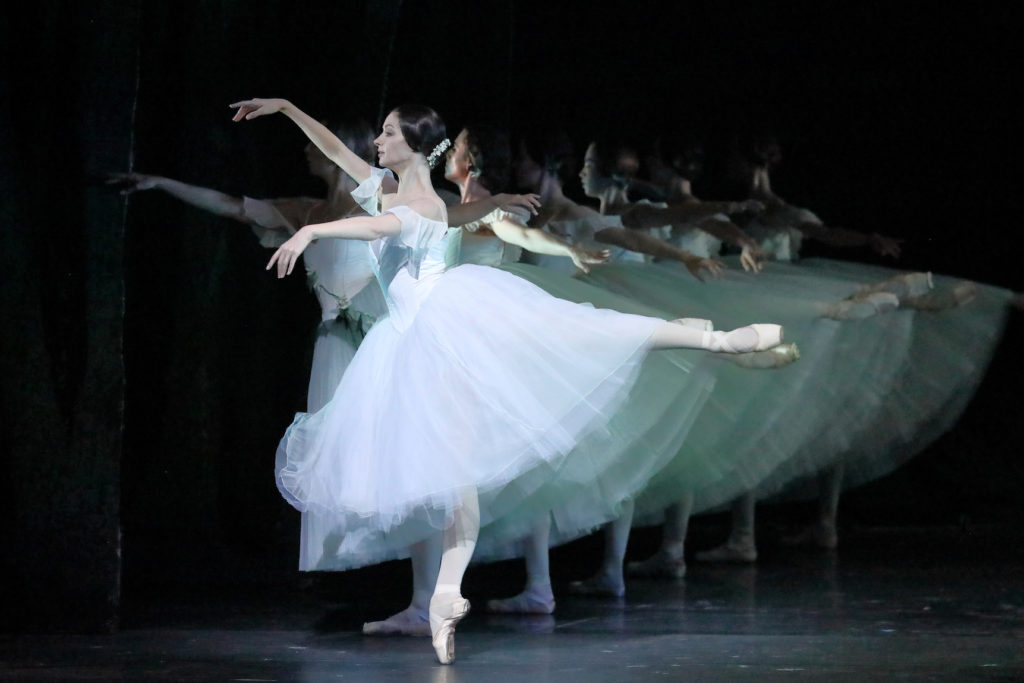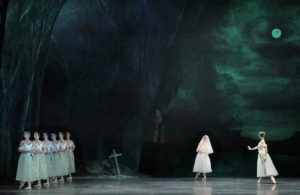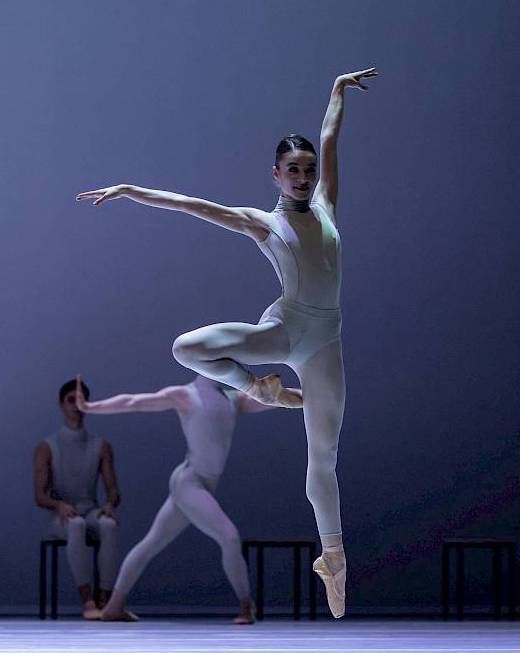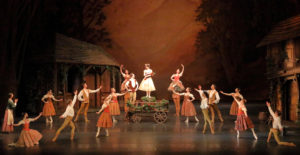In Their Own Universe — Design in Giselle and One Flat Thing, reproduced - Vancouver Ballet Society
- Home
- Features 2020 - 2023
- In Their Own Universe — Design in Giselle and One Flat Thing, reproduced

By Jeannette Andersen
Every choreographic work is an intricate amalgam of many elements combined to evoke feelings and thoughts, perhaps telling stories, perhaps abstract. The choreographer and the set, costume and lighting designers work with forms and lines in space and time, choosing their material with care; for the choreographer, that means the dancers, with their unique presence and training. Considering the choreographic and design elements together makes it possible to read how a dance piece is embedded in a particular world view. Design elements place the dance in a universe of its own, yet every choreography is also a statement about the time in which it was created.
Two very different examples of how design is an integral part of the meaning of every choreographic creation are Peter Wright’s traditional 1985 staging of the classical ballet Giselle for London’s Royal Ballet and William Forsythe’s One Flat Thing, reproduced, created for Ballett Frankfurt in 2000, when he was the company’s artistic director.
Giselle
One of the first and most famous of the Romantic ballets, Giselle premiered in 1841 in Paris. The choreography is by Jean Coralli, though Jules Perrot is said to have choreographed some of Giselle’s dances; the title role was performed at the premiere by Perrot’s protégée, Carlotta Grisi. The libretto — written by Théophile Gauthier with Vernoy de Saint-George and Coralli — was inspired by a Heinrich Heine book in which he mentions the wilis, young women who were betrayed before marriage by faithless lovers; turned into supernatural creatures, they dance men to their death in the woods at night.

Wright, who began his career as a dancer and choreographer, later became famous for his stagings of the classical repertoire. His version of Giselle, created in collaboration with renowned dance and stage designer John Macfarlane, who did the sets and costumes, has been performed by major companies worldwide.
In the first act, set in the real world, across from the cottage where Giselle, a peasant girl, and her mother live is a small hut. Here, Count Albrecht hides his long red cape and sword, which signify his noble rank, something he wants to keep secret in order to woo Giselle. From the start, the audience knows that the story is set in a hierarchical society, reflected in costuming.

The peasants wear simple attire, which gives them the freedom to break out in exuberant dances: the women, including Giselle, are in knee-length dresses in folklore style; the men wear tights and white shirts with simple brown vests. Bathilde (a noblewoman betrothed to Albrecht), her father and their retinue wear long dresses or coats of heavy rich material, reminiscent of the Renaissance. Their costumes are not meant for dancing, perhaps indicating that the nobility is restrained in a world governed by rules and conventions. When Albrecht chooses to dress as a peasant, the disguise liberates him to pursue his dream of freedom.
Bathilde’s high ranking is also made clear when Giselle kneels respectfully to touch the rich fabric of her dress, and when later Bathilde graciously takes off her necklace and places it around Giselle’s neck.

Whereas the first act takes place in broad daylight, the second is set in a moonlit wood, creating a sepulchral atmosphere (the lighting designer was Jennifer Tipton). When the curtain rises, a little lamp directs viewers’ attention to the cross on the grave of Giselle, who, at the end of act one, killed herself after discovering Albrecht’s deceit. This scene starting at the grave establishes a hierarchy in which the power of God, represented by the cross, will ultimately prove stronger than that of the supernatural world, represented by the wilis. At one point, Giselle steps protectively between Albrecht and Myrtha, the queen of the wilis: the cross behind them dispels Myrtha’s power and forces her to her knees.
The wilis, in transparent waist-long veils and long white tutus, with small translucent wings attached to their backs, look like drifting vapours. This “white act” was a convention in Romantic ballets, in which otherworldly creatures dressed in white are symbols of the ethereal supernatural world.
The music, though invisible, is also a strong component in the overall design. Adolphe Adam’s commissioned score accentuates every emotion, and recurrent themes remind the audience of earlier events, as in the motif first heard when Giselle plucks petals from a daisy in order to find out if Albrecht loves her. In this way, the music becomes an instrumental part in telling the story, supporting the world created by design and choreography.
The Romantic period in which Giselle was created had a very specific world view that was clearly represented in the ballet. In reaction to the rationality and objectivity of the Enlightenment, many artists rejected the idea of order, balance, and harmony, and instead focused on nature, folklore, and the exotic, as evident in the escapist fantasy of Giselle’s second act.
Also, at that time, the choreographers, composers, librettists, and the greater part of the ballet audience were men. Like most of the era’s ballets, Giselle represented a male view on women, who were often portrayed as idealized and unattainable.
One Flat Thing, reproduced
If Wright’s traditional staging of Giselle is the epitome of the Romantic world view, American choreographer William Forsythe’s One Flat Thing, reproduced represents a down-to-earth contemporary world view. In its early years, reviews of this one-act ballet — by one of the biggest innovators of classical ballet — were either positive raves or devastating critiques. Today the piece is considered one of Forsythe’s major works, and is in the repertoire of major ballet companies all over the world.

In One Flat Thing, reproduced, instead of an excursion into the fantastic realm of dangerous spirits, Forsythe was inspired by an episode from dangerous and unforgiving real life: the expeditions led by British Robert Falcon Scott to the South Pole at the beginning of the 20th century. On the return journey during their last expedition in 1912, knowing that Norwegian Roald Amundsen had reached the pole first, Scott and his entire crew perished. But you would never guess this inspiration for the ballet if you did not know it: Forsythe has completely removed the story element.
The lighting, which is by Forsythe himself, is bright and sharp, like a sunny day on the ice. The set, also Forsythe’s design, consists of 20 metal tables on a bare stage, which the 14 dancers drag from upstage to downstage at the beginning of the ballet. This action makes a thundering noise, reminiscent of calving icebergs. Each dancer moves with breakneck speed on, under, and in the narrow spaces between the tables, which are as hard and unforgiving as ice floes. A foot hitting a table in a high kick could mean a broken toe, a hip hitting a corner a bruise. It is much like life in today’s crowded cities, which are fast paced and full of challenges that each individual has to handle on their own.

In the costumes, by Stephen Galloway, and movement vocabulary, there is no gender distinction. The dancers wear street clothes, T-shirts, pants and socks in a mix of colours, executing high kicks, lifts, and bends, and throwing each other around. Women and men dance with or support other women and men, or they appear in mixed groups. There are no protagonists and, reflecting contemporary society, equality between the dancers.
The commissioned soundscape by Forsythe’s long-time collaborator, Thom Willems, suggests trickling water and tension between moving earth masses, and ranges from soul-soothing tinkling to aggressive noise. In its own abstract way, the music seems equally inspired by the Scott expedition, evoking the unforgiving universe of nature.
In One Flat Thing, reproduced, the focus has shifted from the individual — from characters with names and back stories — to a nameless collective of people appearing in a plotless ballet set in a world of unforgiving metal tables. Given this abstraction, there is freedom for every member of the audience to interpret the ballet in their own way. Unlike in Giselle, there are no exterior forces to guide or misguide the dancers, just the hard facts of actual tables, which each dancer is left to navigate on their own.

